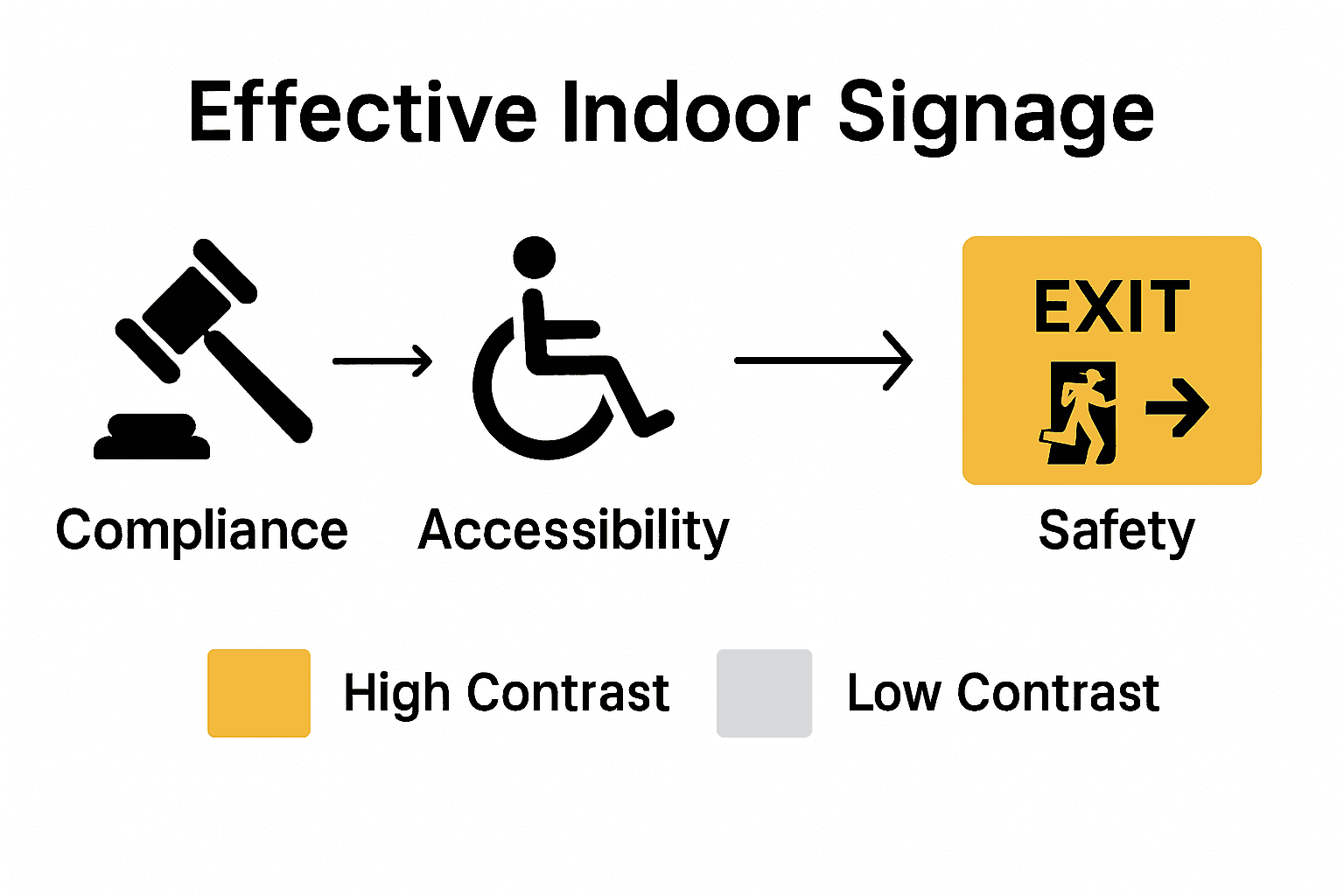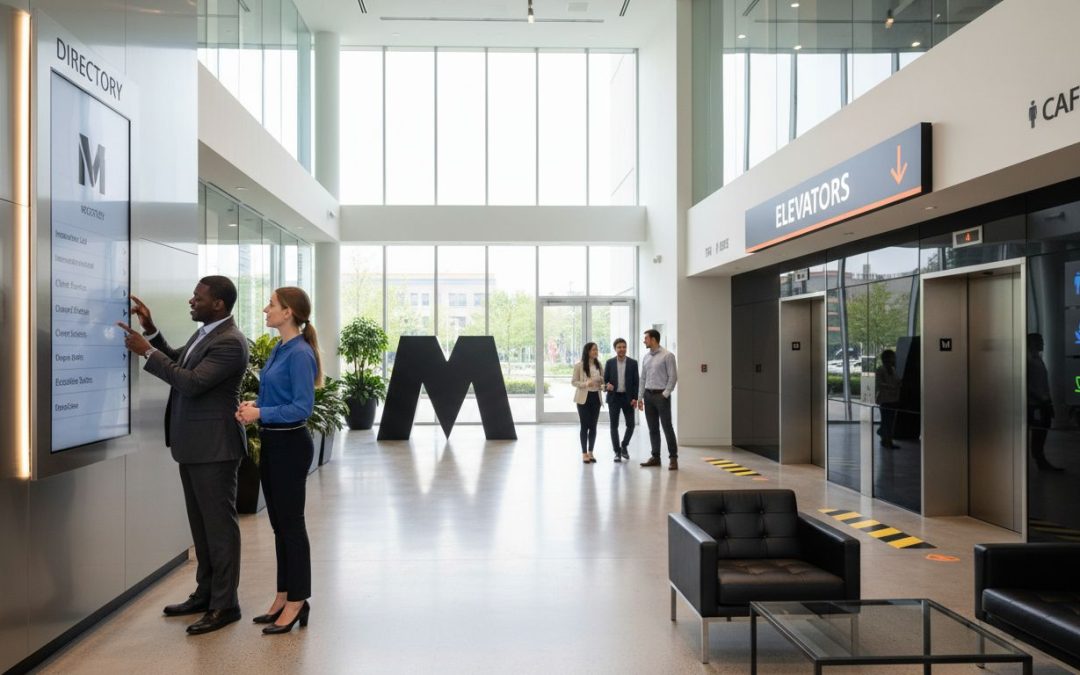{
“@type”: “Article”,
“author”: {
“url”: “https://customsignstoday.us”,
“name”: “Customsignstoday”,
“@type”: “Organization”
},
“@context”: “https://schema.org”,
“headline”: “Complete Guide to the Role of Indoor Signage”,
“publisher”: {
“url”: “https://customsignstoday.us”,
“name”: “Customsignstoday”,
“@type”: “Organization”
},
“inLanguage”: “en”,
“articleBody”: “Discover the role of indoor signage in branding, navigation, safety compliance, and customer experience with this comprehensive guide for businesses.”,
“description”: “Discover the role of indoor signage in branding, navigation, safety compliance, and customer experience with this comprehensive guide for businesses.”,
“datePublished”: “2025-11-20T02:19:41.198Z”
}
Nearly 80 percent of visitors rely on clear indoor signage to navigate unfamiliar spaces without confusion. Whether you manage a business, facility, or public building, the way you guide people inside makes a lasting impression. Effective signage does more than direct traffic; it builds trust, supports safety, and strengthens a brand’s image within each environment.
Table of Contents
- Defining Indoor Signage And Its Core Purposes
- Types And Categories Of Indoor Signage
- How Indoor Signage Impacts Business Operations
- Compliance, Accessibility, And Safety Standards
- Design Considerations And Common Pitfalls
Key Takeaways
| Point | Details |
|---|---|
| Purpose of Indoor Signage | Indoor signage enhances navigation, communicates essential information, ensures safety, and reinforces brand identity within interior spaces. |
| Types of Indoor Signage | Indoor signage is categorized into identification, directional, informational, regulatory, amenity, and temporary signs, each serving distinct communication needs. |
| Impact on Business Operations | Effective indoor signage improves customer experience, operational efficiency, and safety compliance, leading to enhanced organizational performance. |
| Compliance and Design Considerations | Adhering to accessibility standards and focusing on clear design elements help create effective signage that supports inclusivity and meets regulatory requirements. |
Defining Indoor Signage And Its Core Purposes
Indoor signage represents a sophisticated visual communication system designed to guide, inform, and enhance user experiences within interior spaces. According to Boise State University, signage and graphics can be defined as “any object designed to be seen from a public area or within a facility, intended to communicate information, identification, or direction through letters, words, numbers, symbols, pictures, or patterns”.
At its core, indoor signage serves multiple critical purposes for businesses and organizations. These purposes range from practical wayfinding and navigation to communicating essential safety information and reinforcing brand identity. As Oregon Health & Science University highlights, interior signs also play a crucial role in meeting regulatory requirements, including fire codes, building codes, and ADA accessibility standards.
The primary functions of indoor signage can be categorized into several key areas:
- Directional Guidance: Helping visitors navigate complex interior spaces
- Informational Communication: Providing critical details about locations, services, and rules
- Safety Instructions: Indicating emergency exits, hazard zones, and compliance information
- Branding and Aesthetic Enhancement: Reinforcing organizational visual identity and creating cohesive interior design
By strategically implementing well-designed indoor signage, businesses can create more intuitive, welcoming, and efficient interior environments. Learn more about interior signage examples in our comprehensive guide on indoor sign types.
Types And Categories Of Indoor Signage
Indoor signage encompasses a diverse range of visual communication tools designed to meet specific organizational needs. According to Build LACCD, indoor signage can be comprehensively categorized into six primary types: identification, directional, informational, regulatory, amenity, and temporary signs.
Identification Signs serve the fundamental purpose of labeling specific spaces, rooms, or areas within a facility. These might include room number signs, department indicators, or office nameplates that help individuals quickly locate and recognize specific spaces. Directional Signs complement identification by guiding visitors through complex interior environments, providing clear navigation paths and helping people orient themselves effectively.
The different categories of indoor signage play unique roles in communication and user experience:
- Informational Signs: Provide critical details about services, rules, or specific location characteristics
- Regulatory Signs: Communicate mandatory guidelines, safety instructions, and compliance requirements
- Amenity Signs: Highlight available services, facilities, or special features within a space
- Temporary Signs: Offer flexible communication for short-term events, announcements, or temporary changes
Facilities management resources further emphasize the importance of consistent design, recommending standardized color combinations and sizes to ensure clarity and professional appearance. By strategically implementing these various sign types, organizations can create more intuitive, accessible, and user-friendly interior environments.
 Dive deeper into interior signage strategies with our comprehensive guide.
Dive deeper into interior signage strategies with our comprehensive guide.
How Indoor Signage Impacts Business Operations
Indoor signage plays a pivotal role in shaping business operations, extending far beyond mere visual communication. According to RSSAA, consistent indoor signage is instrumental in reinforcing brand identity, enhancing customer trust, and creating a seamless customer experience that directly influences engagement and sales potential.
Businesses leverage strategic signage as a powerful operational tool that impacts multiple dimensions of organizational performance. Indoor signs serve critical functions such as guiding customer flow, improving workplace efficiency, ensuring safety compliance, and creating a professional environment. By providing clear, intuitive navigation and information, organizations can reduce confusion, minimize staff interruptions, and create a more streamlined operational experience.
The multifaceted impact of indoor signage on business operations can be understood through several key dimensions:
- Customer Experience: Simplifying navigation and reducing customer frustration
- Operational Efficiency: Reducing time spent on directional inquiries
- Brand Perception: Communicating professionalism and organizational competence
- Safety Compliance: Clearly marking critical areas and potential hazards
- Employee Productivity: Creating clear, structured workplace environments
By implementing thoughtful, well-designed indoor signage, businesses transform their physical spaces into more intuitive, engaging, and productive environments. Explore our comprehensive guide on indoor signage solutions for business success to understand how strategic signage can revolutionize your operational approach.
Compliance, Accessibility, And Safety Standards
Indoor signage plays a critical role in meeting complex regulatory requirements that protect public safety and ensure equal access for all individuals. According to Oregon Health & Science University, organizations must adhere to stringent guidelines including the 2010 ADA Standards for Accessible Design, which provide comprehensive specifications for regulatory signs such as restroom and stairwell identification.
Accessibility standards encompass multiple critical dimensions of sign design and placement. This includes precise requirements for typography, color contrast, mounting height, and visual clarity that ensure signs are readable and comprehensible for individuals with diverse abilities. Build LACCD emphasizes the importance of creating signage that goes beyond mere information transmission to actively support inclusive navigation.
Key compliance considerations for indoor signage include:

- Visual Clarity: Ensuring high contrast and legible typography
- Mounting Standards: Precise height and placement guidelines
- Universal Design: Creating signs accessible to people with different abilities
- Safety Communication: Clearly marking emergency exits and potential hazards
- Regulatory Adherence: Meeting ADA, fire code, and building code requirements
By prioritizing compliance and accessibility, businesses demonstrate a commitment to inclusivity and safety. Learn more about ADA signage requirements in our comprehensive guide to ensure your indoor signage meets the highest standards of design and functionality.
Design Considerations And Common Pitfalls
Designing effective indoor signage requires a strategic approach that balances aesthetic appeal with functional communication. According to RSSAA, consistency is paramount in signage design, as inconsistent visual elements can create confusion and undermine customer confidence in an organization.
Successful indoor sign design demands careful attention to multiple critical elements. Typography, color palette, material selection, and placement all play crucial roles in creating signs that are not just visually appealing, but also highly functional. Organizations must consider factors such as readability from different distances, visibility under various lighting conditions, and alignment with overall brand identity.
Common design pitfalls that businesses frequently encounter include:
- Overcrowded Information: Trying to include too much text or visual elements
- Poor Color Contrast: Selecting color combinations that reduce readability
- Inconsistent Branding: Misaligning sign design with overall brand standards
- Inappropriate Sizing: Creating signs that are too small or disproportionate
- Neglecting Accessibility: Failing to meet universal design requirements
Learn how to design custom signs for impactful visual branding and transform your interior communication strategy with thoughtful, purposeful signage design.
Transform Your Space with Expert Indoor Signage Solutions
The challenge of creating clear, accessible, and brand-consistent indoor signage is real. From guiding customers smoothly through your facility to meeting strict ADA compliance and safety standards, your indoor signs need to do more than just look good. They must communicate with precision and professionalism. At Custom Signs Today, we understand how essential well-designed indoor signage is to enhancing customer experience, operational efficiency, and safety. Whether you need identification, directional, or regulatory signs, our custom solutions will help you avoid common design pitfalls and deliver impact where it matters most.

Discover how our wide range of signs crafted with high-quality durable materials can elevate your business environment and make navigation effortless for every visitor. Act now to create signage that not only meets compliance but also reinforces your brand identity with expert craftsmanship and attention to detail. Explore our Uncategorized signage options and visit Custom Signs Today to request your free quote today.
Frequently Asked Questions
What are the primary purposes of indoor signage?
Indoor signage serves several critical purposes, including providing directional guidance, communicating essential information, indicating safety instructions, and reinforcing brand identity within a facility.
How do compliance and accessibility standards affect indoor signage design?
Compliance and accessibility standards, such as the 2010 ADA Standards, require that indoor signage meets specific criteria for typography, color contrast, visual clarity, and mounting height to ensure safety and accessibility for all individuals.
What types of indoor signage are commonly used in facilities?
Common types of indoor signage include identification signs, directional signs, informational signs, regulatory signs, amenity signs, and temporary signs, each serving unique communication roles within a facility.
What design considerations should be taken into account when creating indoor signage?
Key design considerations for indoor signage include consistency in typography and color palette, appropriate material selection, visibility under various lighting conditions, and ensuring readability from different distances.
Recommended
- What Is Indoor Signage? Complete Guide for Businesses –
- 7 Essential Examples of Indoor Signs for Business Success –
- Interior Signage Step by Step for Business Success –
- Interior Signage Explained: Types, Uses, and Compliance –
- 7 Essential Safety Signs Every Canadian Restaurant Needs – Probe IT
- Understanding Digital Signage for Offices: Key Insights – Projector Display

